How To Make Money On YouTube (From a 7-Figure YouTuber)
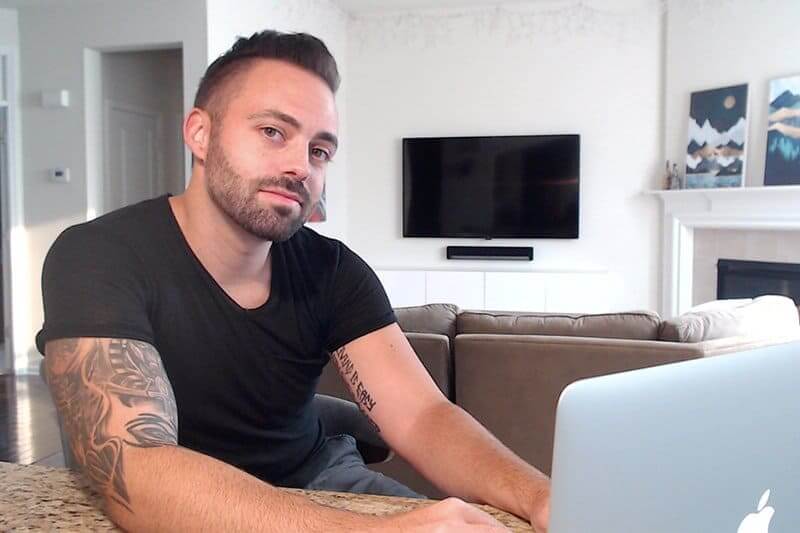
In this guide, I’m covering exactly how to make money on YouTube with a brand new channel this year.
For starters, why should you trust my advice?
I’ve grown my YouTube channel to 205,000+ subscribers and over $100,000 per month through affiliate marketing, ads, courses, and sponsorships in less than 2 years.
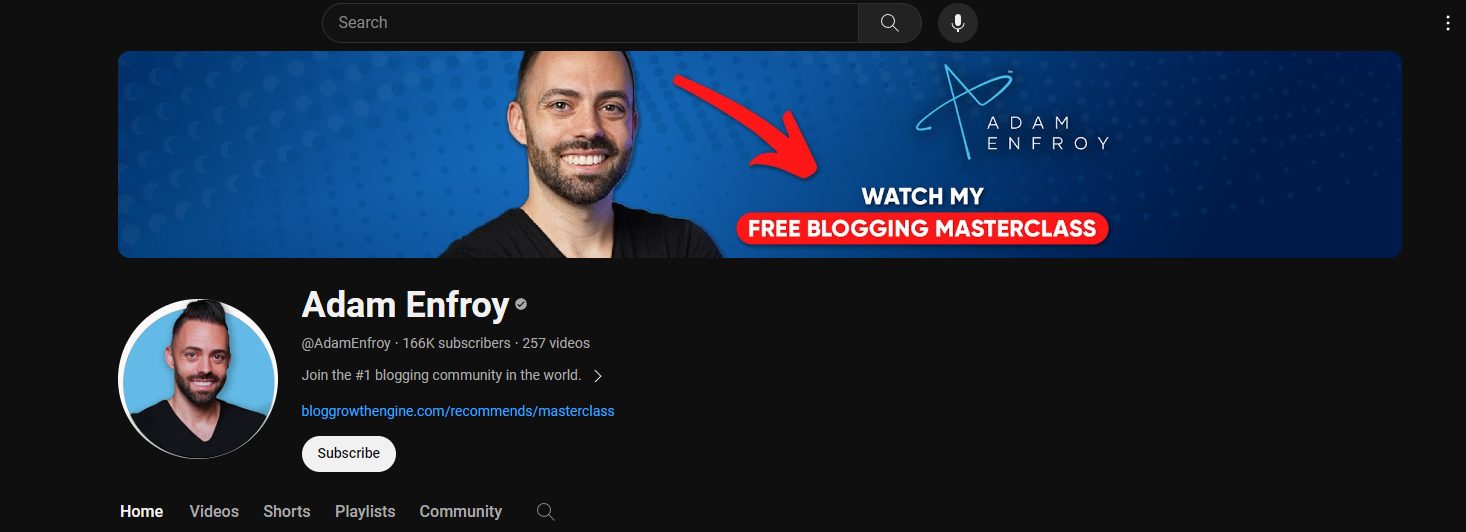
If you want to learn how to make money on YouTube, then you’ve come to the right place…
The 4 YouTube Monetization Methods We Built Our Business On
Here are the 4 main methods we use on our YouTube channel:
- Affiliate commissions
- Sponsorships
- YouTube Partner Program (Ad Revenue)
- Course Sales
In the following sections, I’ll dive deep into each one, showing you how we use these methods to make money on YouTube. You’ll see which ones best apply to you and your YouTube journey.
Before I dive into this article, you can also check out this guide if you want to focus on using AI to make money on YouTube. Combining the information in these two articles will give you a great start to YouTube success.
1. Affiliate Marketing: Use other people’s products to make money
Making affiliate commissions might be the easiest method to monetize your YouTube channel.
As you create video content around a main topic (and its various subtopics), you mention products that are of interest to your viewers. When someone checks out and buys the products, the company pays you a commission on the sale.
This is a great deal for companies as they only pay out when they have already gotten money from a sale. No need to hire salespeople and pay them whether they make them money or not.
For you, this is also great as you don’t have to create your own products or deal with customer service.
For the person buying the product, this is also a win-win. Thanks to your video, they will be more knowledgeable about a product (or service) that can help them with their needs. Through your links, it’s also super accessible for them to purchase.
Here’s a list of video types (along with examples) that allow you to include affiliate links naturally.
How-to videos
These videos provide information on the steps involved in achieving an outcome. Products and services generally make achieving these outcomes easier.
For example, if you’re in the gardening niche, a video on how to grow your own tomatoes (along with links to specific seeds) could be very helpful. If your audience wants to care for succulents, including links to buy potting soil, watering cans and more could be beneficial.
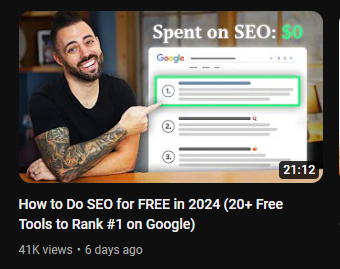
Above is an example of a video where I provide a complete tutorial on how to do SEO. I also provide a list of tools to help viewers get better results. This presents a great opportunity to include affiliate links.
Best X products/ways/methods
Before making a buying decision, people want to compare what’s available.
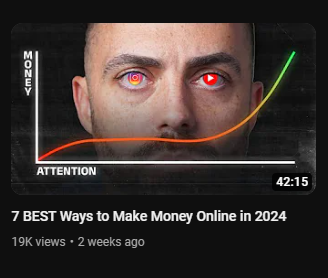
A list of the best X products (where you compare benefits, features, pricing, ease of use, etc) can help make people’s buying decisions easier.
Single product review
Have a specific product you could dive deep on? Dedicating a whole video to reviewing the product allows you to provide helpful content. Say you’re in the tech niche. What if you created a video exploring a product’s settings, use cases, pros and cons, etc?
By the end of the video, the buying decision would be an easy yes/no for your audience. There would be no ifs or maybes.
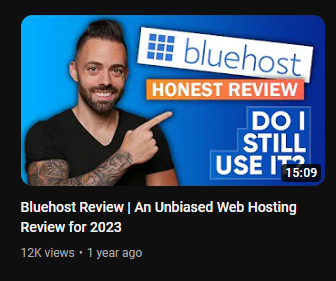
In the above video, I create a complete review of Bluehost, showing my experience with it, the pros and cons, and much more.
Versus Videos
Comparing two products head to head is also a great type of video to create. Sharing affiliate links and monetizing your expertise also comes naturally with these videos.
For example, comparing the PS5 vs. the Xbox Series X (while including your affiliate links) makes sense, as these are direct competitors. Another example is comparing the Insta360 Ace Pro action camera with GoPro’s Hero 12.
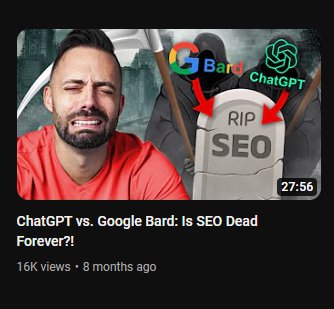
This applies to any niche or industry. In the video above, I compare ChatGPT against Bard, showing the pros and cons of both tools. Again, the opportunity to include affiliate links comes natural.
Should you buy the products yourself?
In most cases, yes.
Shooting a video talking about a product you’re not physically holding doesn’t really work.
My suggestion would be to feature the product where possible. Even better would be reviewing products you already use. That’s when you can provide real, honest reviews.
“But what if I’m reviewing expensive and/or luxury items?” Consider a channel reviewing luxury watches. With potential price tags ranging in the thousands of dollars per watch, it’s tough to buy a different watch per video.
In this case, some YouTubers create a “reaction video”. They take someone else’s video and give their opinion on its content.
If you’re reviewing software, getting a trial version can work. Then record a screen share while using the software.
Different ways to promote affiliate links
You don’t want to ‘spam’ people with your affiliate links. Doing so is a great way to get someone to never come back to your channel, let alone buy through your links.
Instead, you be tactical with your link placement. Here are some ideas:
- Video description: This is the lowest-hanging fruit. Place your link in the top part of the description (so it’s not cut off) and ensure you give people a reason to click on it. Don’t just paste the link in there and hope. Words like ‘check out’, ‘get the best deal here’ and ‘purchase this product now’ can encourage more clicks.
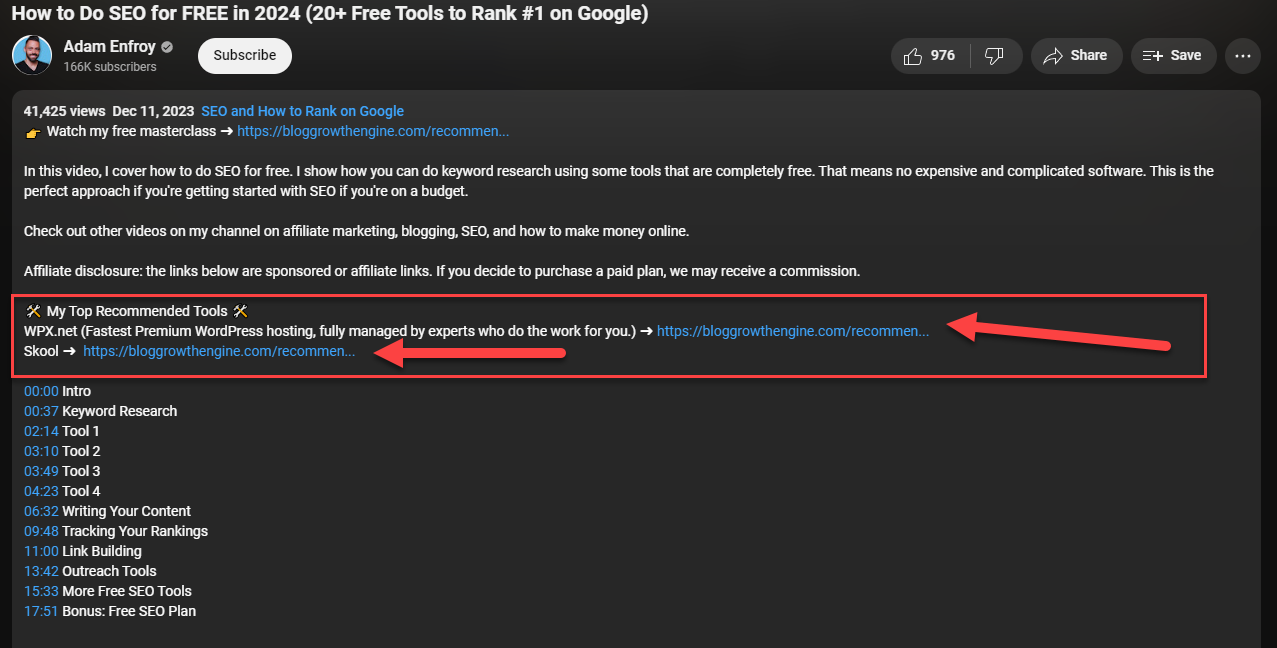
- In video mentions: Mention you have links in the description. This gets people to check out these links. I recommend mentioning these links at the start of the video, at the end and at times when you’re showing the product itself. Just don’t overdo it.
- Lower thirds: Having a lower third graphic on the screen (for a few seconds at a time) can get people to click your links.
- Pinned comments: Personally, I love checking what people are saying about a video. I think it’s all part of YouTube social proof’s aspect. This makes the comments section (specifically the first, pinned one) a great spot to place your affiliate link.
Disclosing affiliate links
People need to know you will be compensated if they buy through your affiliate links.
Being clear about this is the right thing to do. Honesty leads to a healthy long-term business.
Secondly, it’s also a legal requirement in most countries.
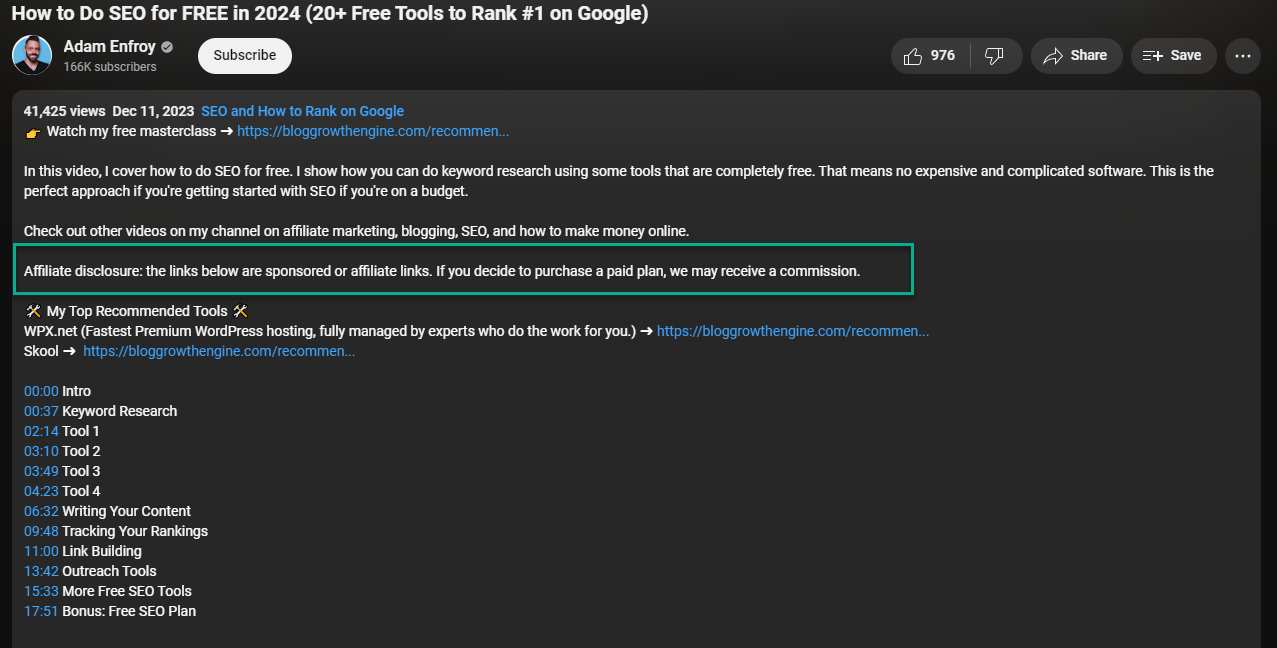
I encourage you to mention that you will get a commission in your YouTube description (or even in the video itself).
A note on affiliate networks
You can start promoting affiliate products in your videos from day one. However, it’s easier to get accepted into affiliate programs if you have a YouTube channel with some subscribers and video views.
Joining an affiliate program is usually as easy as filling in a form. There are also affiliate networks that host multiple affiliate programs. Some of the most well-known include:
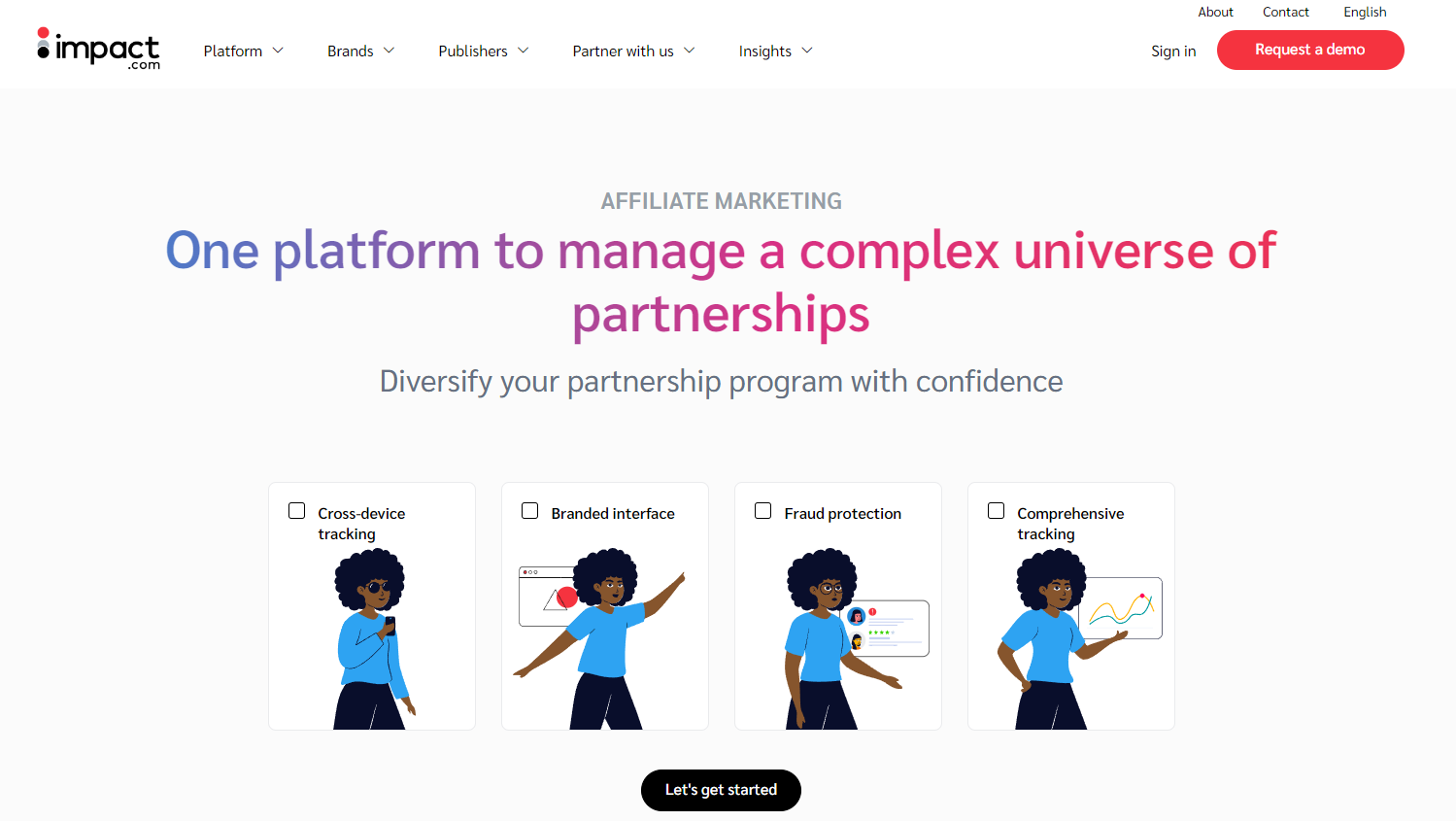
Image credit: https://impact.com/affiliate-marketing/
You’ll generally be assigned an affiliate manager when you join an affiliate network. Building a relationship with this person can be very beneficial. Your affiliate manager can help increase your commission percentages and give you ideas on how to get more purchases.
Moreover, affiliate relationships can also open the doors for sponsorships (more on this in the next section).
In short, do not underestimate the importance of affiliate relationships.
2. Use sponsorships to generate consistent income
Want even more control of your video monetization? Consider getting video sponsorships.
With sponsorships, you get companies to pay you for mentioning them during your videos.
There are 2 types of sponsorships:
- Ad spots: Here, you (or the company) record a 30-second clip that you insert into your video. Unless well-timed, this interrupts the natural flow of the video and causes viewers attention to divert.
- Natural mention: If you’re using a product in the video (and the company behind the product is sponsoring such video), a natural mention might be better. Here you mention the company as you use the product. You might have to be a bit more creative with this approach but the upside is that you don’t interrupt your viewer’s attention as much.
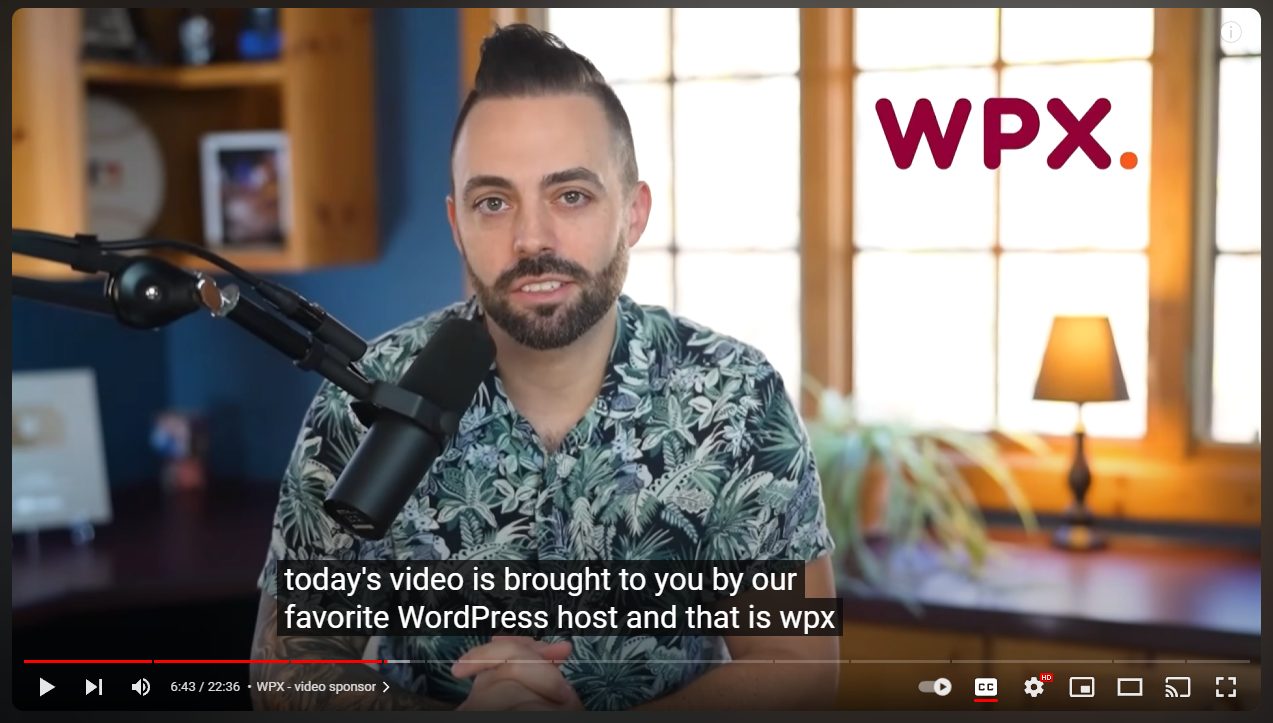
Whichever method you choose, the best sponsors are those whose products you use everyday in your business life. It’s much easier to make the right recommendations when these come from the heart.
While it’s not always possible to be a direct consumer, it’s worth considering this.
What makes a bad video sponsor?
Here’s a quick list of sponsors to run away from:
- A sponsor that forces you to change your video content calendar based on THEIR needs
- A sponsor that wants you to mention their product in very specific ways or at specific timings.
- A sponsor that wants way too much access to YouTube channel data
- A sponsor whose values do not align with your brand
- A sponsor that doesn’t understand the value of your YouTube audience
- A sponsor that doesn’t agree to pay your sponsorship fee as you define it
The best sponsors understand that your targeted YouTube audience (that knows, likes and trusts your recommendations) will bring them a much higher return on their investment than the cost of sponsoring your video.
So what data does the right sponsor want to know?
Generally, sponsors will be interested in two data points:
- your monthly video count and
- your average video count.
What’s required of both will vary depending on the niche.
How much should I charge sponsors?
This also depends on the niche. Generally, I would suggest having a flat fee structure for a set number of months. This makes life easier for everyone involved.
How do you find sponsors?
At first, you might have to contact companies you want to work with. Try to find people whose job titles include:
- Affiliate manager
- Partnership manager
- Marketing manager
These people should be able to either help you themselves or direct you to those who can. Finding these people through LinkedIn (along with software like Hunter.io) is generally the easiest way.
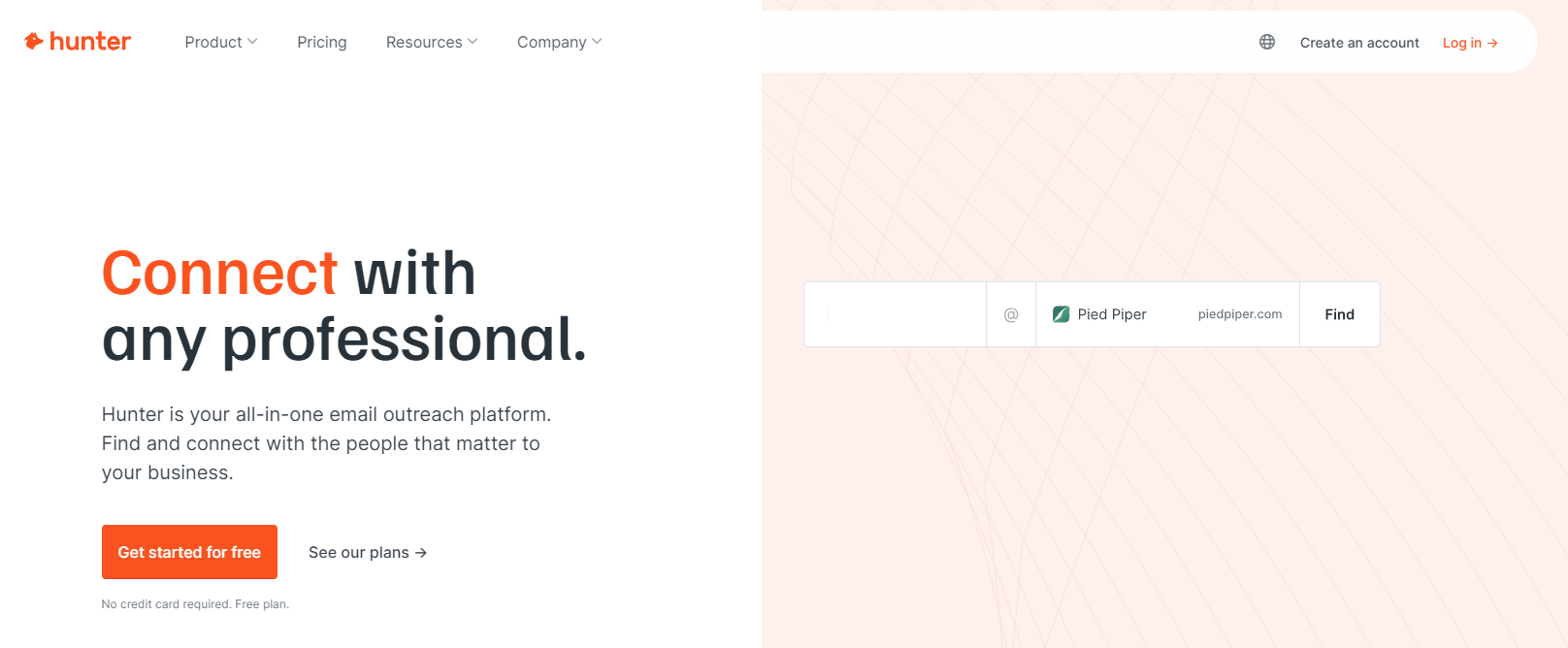
Image credit: https://hunter.io/
Suppose you already have a relationship with affiliate managers (such as through promoting their products). In that case, you should also consider speaking directly to them and asking if they want to sponsor your videos.
Know your numbers (including the view counts I mentioned earlier) when reaching out. Also, consider how your YouTube channel could add value to the company. Clarifying what they’ll get (instead of what you’ll take) is key to a successful pitch.
Knowing your content schedule and where their company would best fit in can also help you get a positive reply.
3. Profit from the YouTube Partner Program
YouTube’s Partner Program (YPP) allows creators to make money while building “vibrant and diversified businesses “.
The main YPP aspect we use in our business focuses on ad revenue. When people advertise on our videos, we earn a share of that revenue.
I listed this method in the third position as it’s not something you can immediately start using when starting your YouTube channel. There are several factors you must satisfy before getting accepted into the program.
These include:
- Monetization policies
- Location requirements
- Have a channel without strikes
- Have 2-step verification enabled
- You’ve set up an AdSense account
- You’ve hit YouTube’s eligibility thresholds
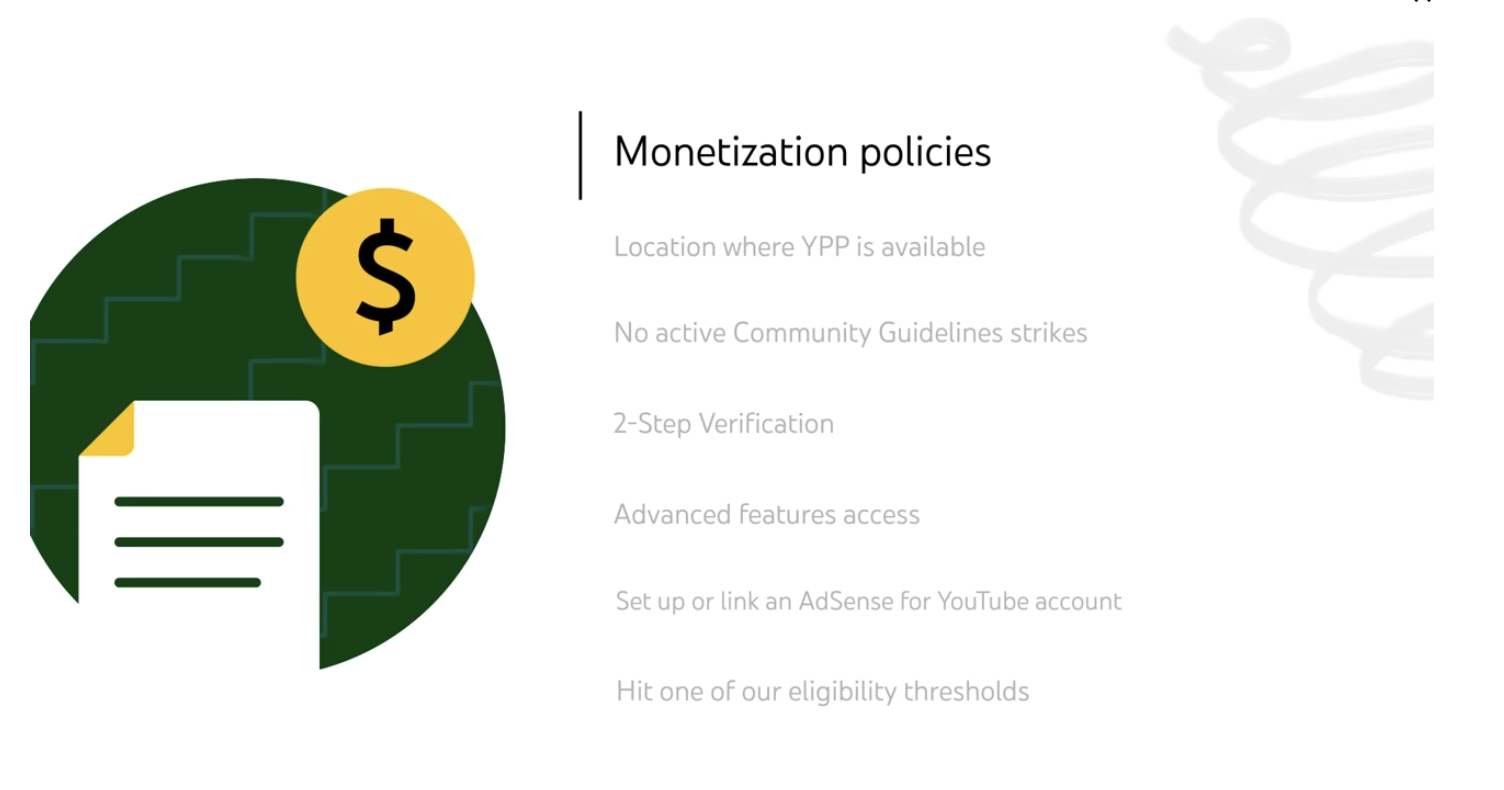
Image credit: https://www.youtube.com/
Here’s what you should know about eligibility requirements.
YouTube Partner Program Eligibility
To be able to apply for channel monetization, you must have:
- 500 subscribers
- 3 valid public uploads (within a 90-day period)
- 3,000 public watch hours OR 3,000,000 public short views
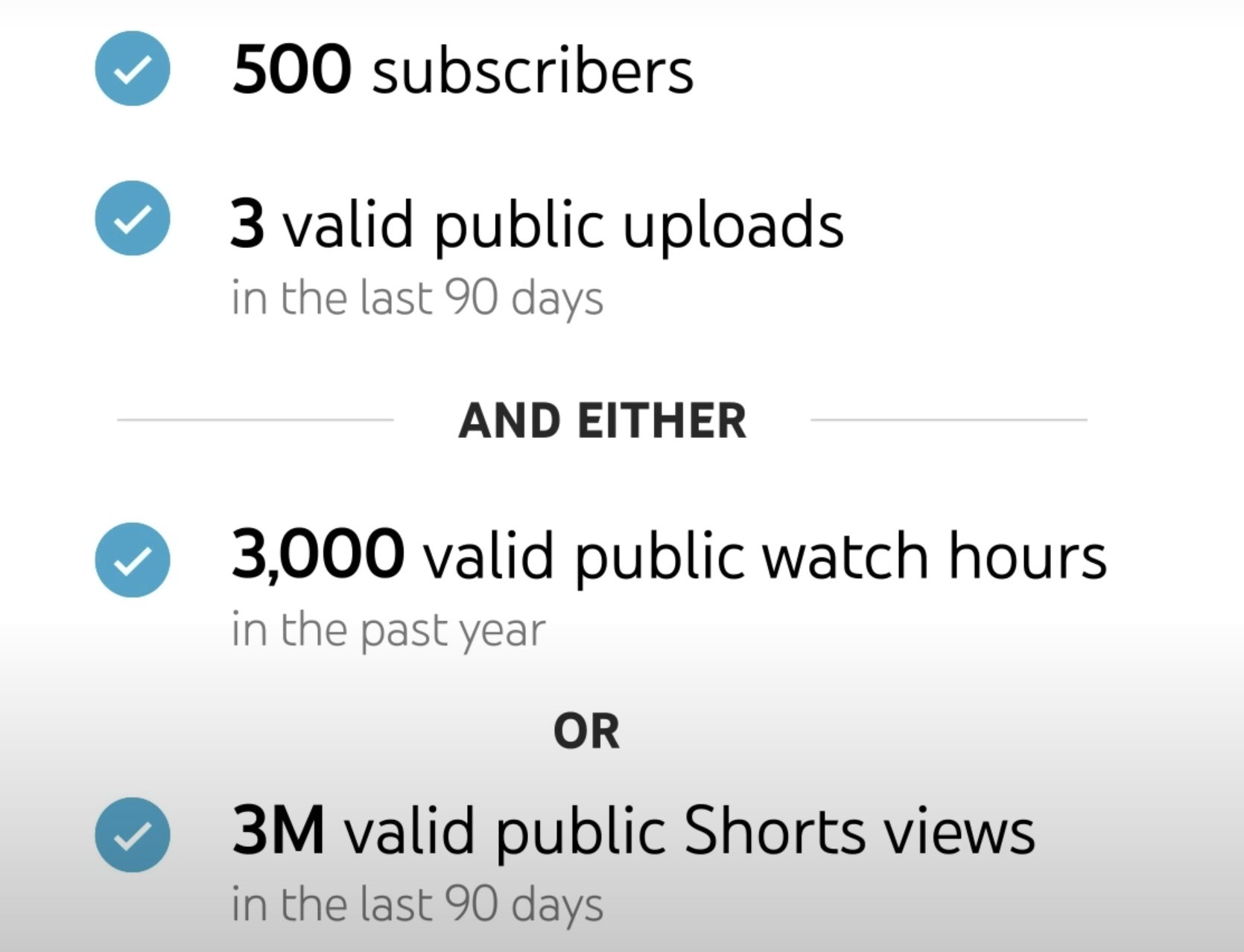
The best way to get to these numbers? Creating high-quality content consistently.
The more content you create, the better you’ll be able to see what’s working with your audience. This also makes it easier to apply the feedback you get with new videos.
How much does YouTube pay?
As with many questions in this article, it depends on the industry.
On average, there’s a $2-$4 average payout on every 1000 views within the entertainment niche. With finance and business, the average is between $20-$40.
Also, a channel with a broader audience will generally get paid less than those with more targeted audiences.
Compared to affiliate commissions, sponsorships, or even creating your course (see the next section for this), YouTube ad revenue will probably make up the least amount of money. That’s what happens in our business.
This method is also the one where we have the least control.
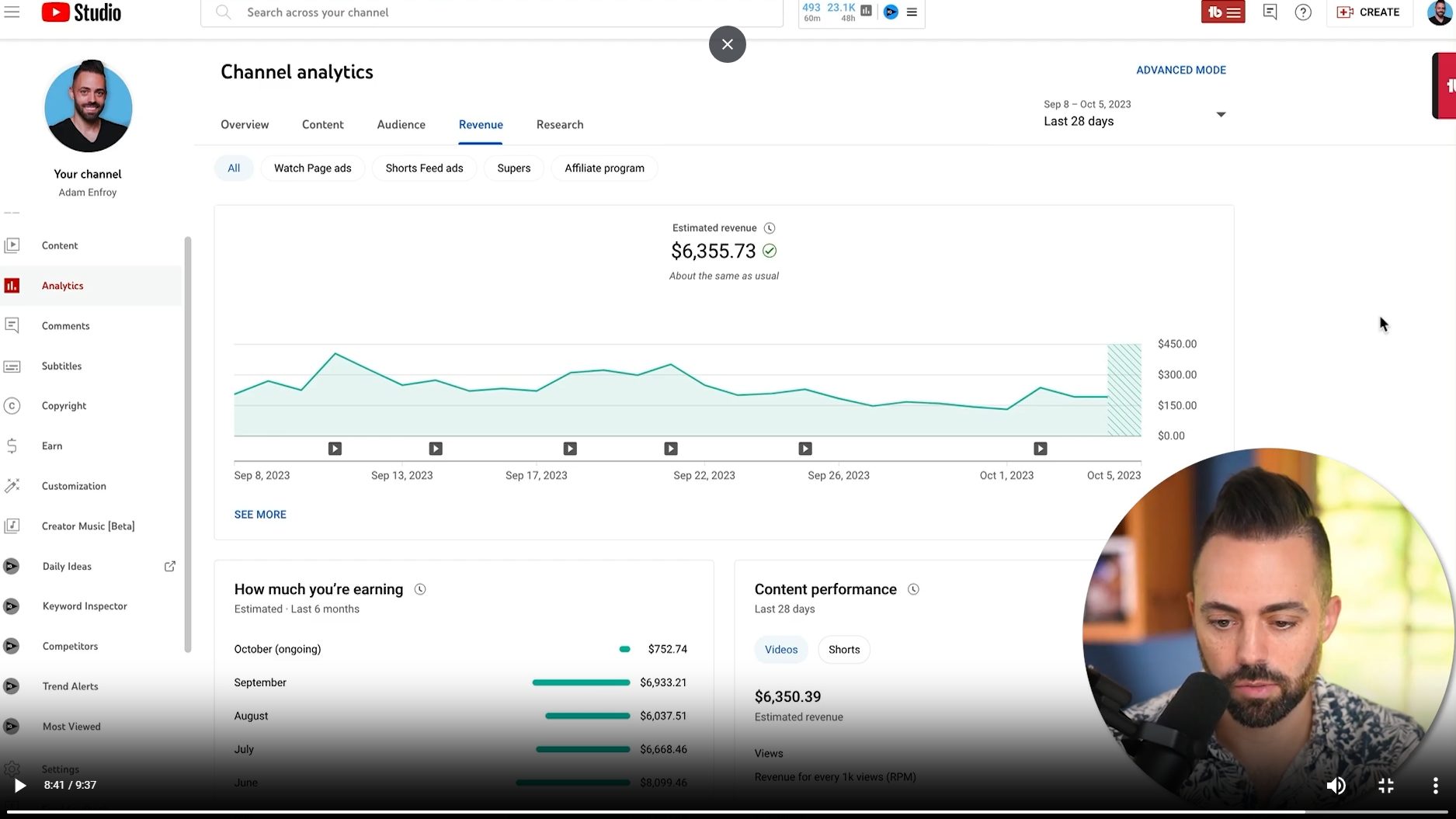
We can’t make people advertise on our videos and can’t force people to click on those ads. At the same time, it’s still a monetization channel that pretty much runs on autopilot once it gets going.
4. Build and sell multiple online courses
This method is the ultimate leverage you can use to monetize your YouTube channel. Thanks to YouTube, selling your own courses also becomes much easier compared to other marketing channels.
Why is this so? Consider the people who find you through YouTube’s search or suggested videos. They watch your content and learn what you stand for (and against), your expertise and how you can help them.
Through watching your content (over multiple hours, days, weeks or even months), they start building a relationship with you.
Then, they learn that you offer products and services to help them achieve the desired results. Even better, they would be able to get such results faster/easier/better than they could by just watching YouTube videos.
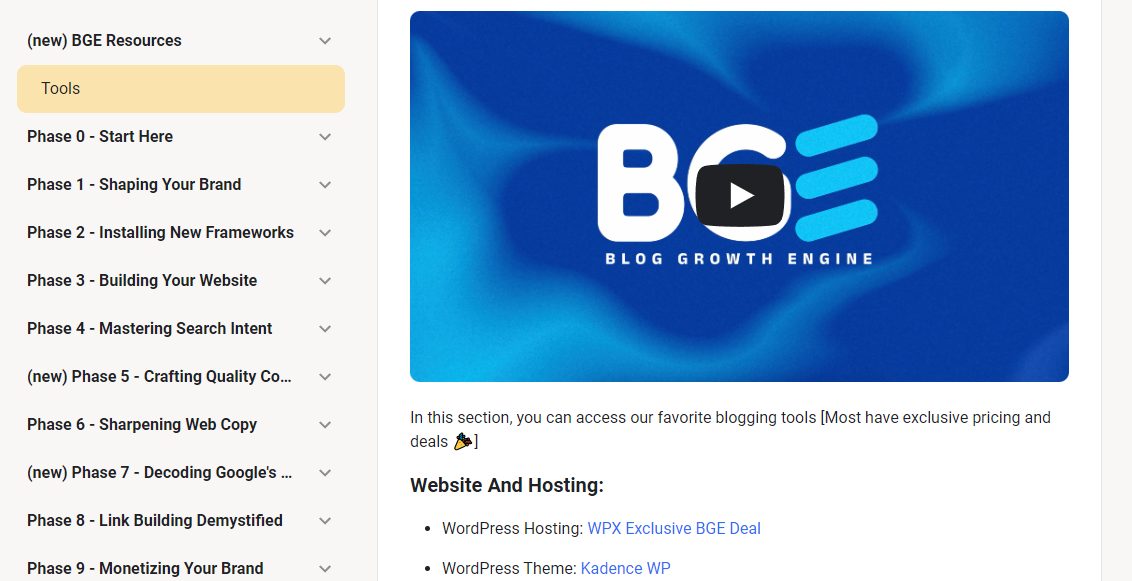
And the way you deliver such results is through building your own courses.
YouTube video structure vs your course
YouTube videos can be pretty entertaining. They can also be unstructured, unorganized and a little over the place.
Based on their search history, algorithm suggestions, etc someone can watch a video about a topic (within one niche) and then end up watching an unrelated video that’s still within the same niche.
Within a course, things are way more organized. After all, a course should help people follow specific steps to get a set outcome.
For those who want more of your content in a structured format, an online course is the next best thing after your YouTube content. Also, selling a course to your YouTube audience is a relatively easy sell (pun intended).
You would have already done the hard work of showing these people you can help them. This is why providing high-quality information in your free stuff is so important.
Moving people from YouTube to an online course
With selling an online course you have to get people off YouTube and onto your website.
While the process of setting up your online course is beyond this article’s scope, here’s the flow people might go through:
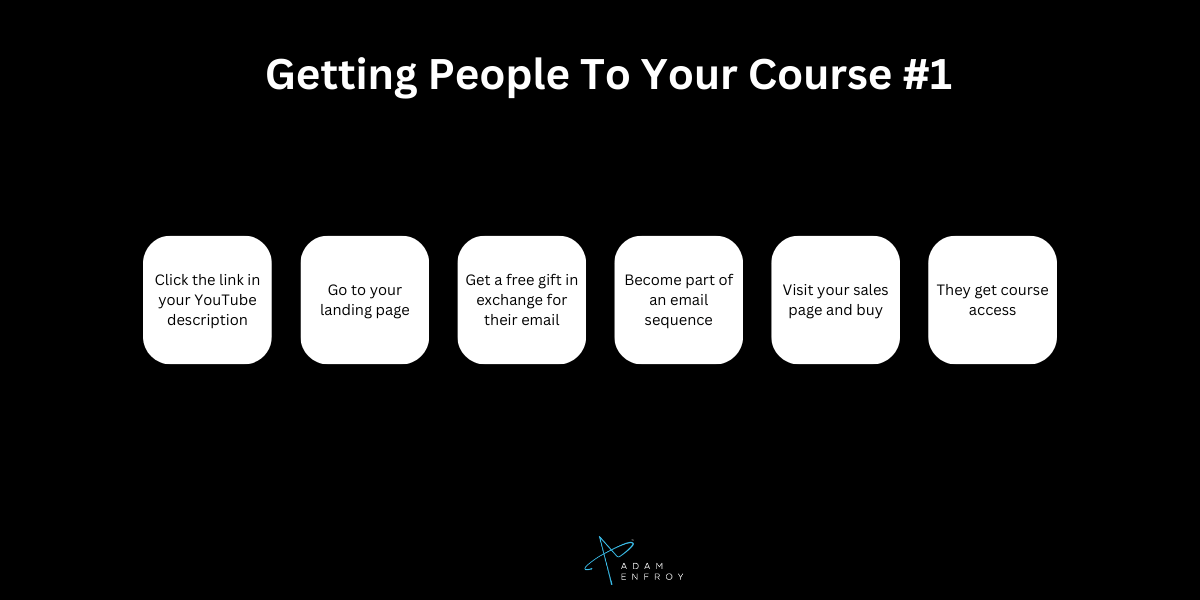
- They click the link in YouTube video description
- They end up on a landing page on your site
- They get a free gift in exchange for their email
- They become part of an email sequence
- They visit your sales page and buy
- They get course access
If you wanted to go simpler, you could also set things as such:
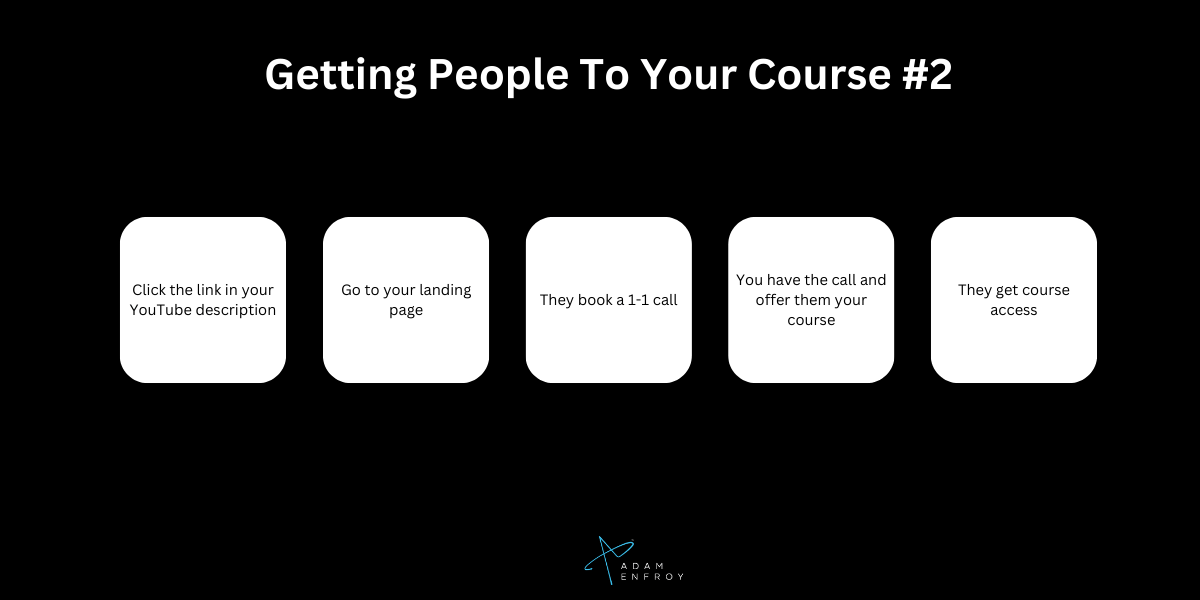
- Link in your YouTube video’s description
- Get people to a landing page where they book a call
- You have the call with them
- They buy and get course access
Following the second approach means you’re providing a more personalized experience. Since people will get to go on a call with you (i.e., the actual person from YouTube!), you’ll already be seen as an authority in their eyes.
While this might not sound like a lot to you, it will be for the people and how they perceive their time with you.
Getting on a call, stating their problems and prescribing them a solution (which in most cases would be your online course – if it’s relevant to them) is a great way to turn YouTube viewers into long-term customers.
The only issue with this method is that you can do much less volume than the first one. It’s much more hands-on. Knowing how you want to run your business is key.
Using YouTube To Build An Online Course Business
Here are the steps you’ll need to follow:
- Build an audience: By creating and publishing YouTube videos (while focusing on quality and quantity), you’ll start building your audience. The best audience is the one that enjoys your content (entertainment), gets educational value from it, and looks forward to the next video
- Create and validate your offer: As you understand better what your audience needs (and wants) from you, you start building an offer. This involves all the components of what you’ll be selling: the main product, bonuses, upsells, downsells and backend programs all go into this.
- Shoot your course: If you’re creating a video course, you have to dedicate time to shooting it. The aim is to provide a much higher value to your audience than the price they’ll eventually pay.
- Create a community: We firmly believe that an online course and a community go hand in hand. Building this combination allows you to charge higher prices and give people a more valuable experience.
- Decide on the price: Pricing your course depends on various factors including the value you’re providing, your target market’s resources, and what your competitors charge. Finding the right price point generally comes from testing multiple ones to see how high you can go while getting the most sales. This generally takes some trial and error to get right.
- Update the course: Pretty much all courses will need an update from time to time. In a world where information changes rapidly, ensuring your course stays relevant is essential.
- Run regular promotions: People won’t buy unless they know what you’re offering. Ensure you let people know how your course will benefit them and how they can get it. Do so regularly.
Overall, it’s a pretty simple strategy. It’s also the strategy we use to grow our course sales – both Blog Growth Engine and YouTube Growth Engine.
Focusing on long-term customer service
Selling an online course requires both a short and long-term business approach.
The better job you do as soon as someone becomes a customer, the better word of mouth you generate.
Starting with good onboarding and customer support, you want to set the right tone from the first moment. Keeping student success as the main focus of what you do is crucial. Sometimes even the smallest things make a big difference.

Ask students how they’re getting along, provide help as needed and don’t be afraid to highlight their successes.
The importance of a thriving community is also worth another mention. Having people engage with your community posts, helping others and looking forward to future Q&A calls is tough to beat.
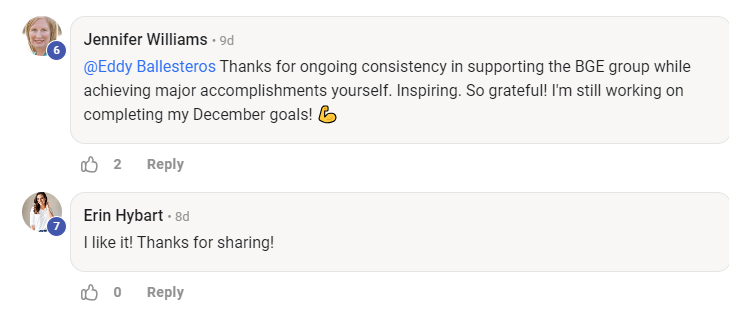

The more satisfied customers you have in your course, the more people will learn about your YouTube channel. This leads to more views, subscribers, customers, etc.
In other words, it’s all tied together.
Why YouTube monetization has been taught wrong
“I won’t be successful unless I have thousands (or even millions?) of subscribers”, I remember thinking over and over.
It’s probably why I failed to start my own YouTube channel for many years.
However, the more I understood what success meant (in terms of YouTube monetization), the more I realized one important truth:
The number of subscribers a channel has doesn’t matter.
You can start making money with just 1000 subscribers or even 10,000 subscribers.
Obviously the more the merrier but it’s not just about subs.
So why do those teaching YouTube monetization focus so much on quantity?
I think it’s just good for the ego. In today’s creator world, everyone tries to shout louder than the next person. This makes having millions of subscribers sound good (on paper).
But what’s the use of having many subscribers if they don’t feel your content provides them value?
No one wants to be the influencer with 2 million followers who couldn’t sell 36 t-shirts.
If you want to make money on YouTube (lots of it and over the long term), you need to look at those actually doing it.
And you know what they all have in common? Here’s a quick list:
- They understand what their audience really wants
- They create content that addresses these wants (along with the needs).
- The more value they provide, the more people (the ‘right type’) find their content
- More people like their videos, subscribe to their channel, buy their products, etc.
This also brings me to what was traditionally known as the “expert model”.
Do you have to be an expert to succeed?
No.. and that’s great news!
Most people don’t start their YouTube journey because they feel they’re not YET an expert.
In reality, people watching YouTube want to relate to others when watching videos. Seeing someone that’s 100 steps ahead of them makes it tough to relate.
Instead, understanding someone has been in their position and figured out the solution (and is now just a few steps ahead) is usually more appealing.
After all, the internet is full of beginners in various subject areas.
What does this mean for you?
If you have something of value to share (even if you don’t consider your skill level advanced), people WILL watch your content and this means you’ll make money on YouTube.
Short and long term YouTube monetization
YouTube also opens up multiple opportunities for you as a content creator.
Once you have people’s attention (i.e., the currency of today) and trust (being authentic on video helps a lot), you can direct such attention as you please.
Moreover, the four types of YouTube monetization methods I’ll describe below can be JUST the start of your business journey. Plenty of YouTube creators have gone on to build successful companies, open restaurants and more.
Mr. Beast started creating videos 11 years ago. His first videos didn’t have anywhere near the production value his videos have now:
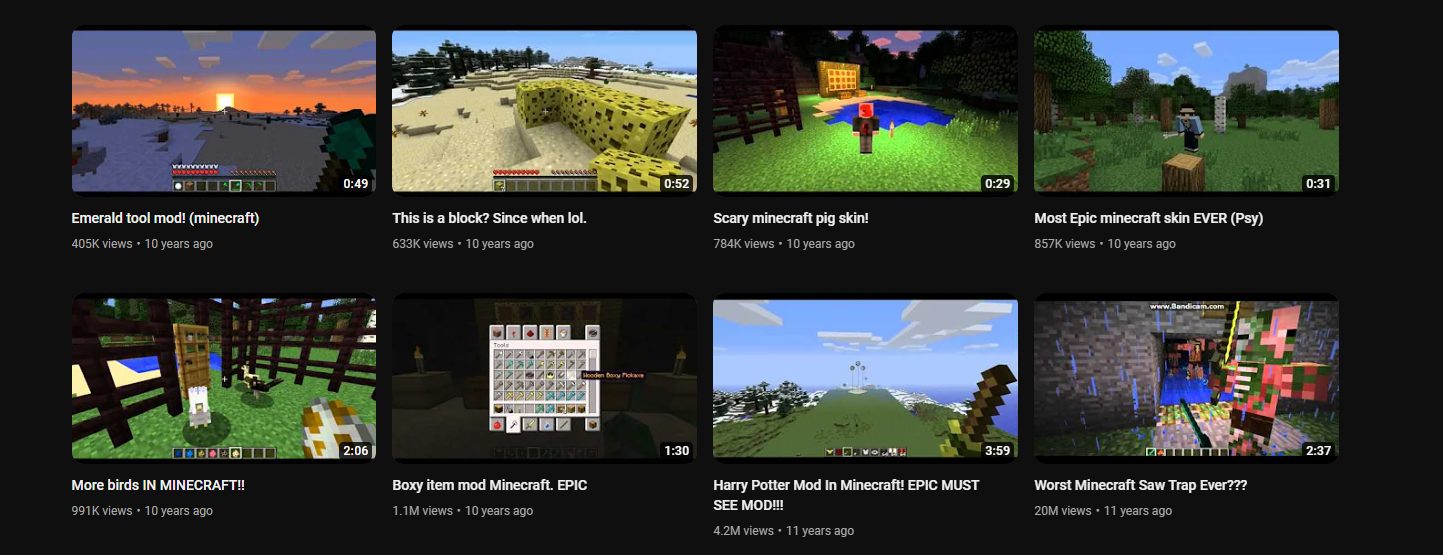
Image credit: youtube.com
Over time, he built up his audience (in multiple YouTube channels) and has now opened over 600 restaurant locations in 45 states:
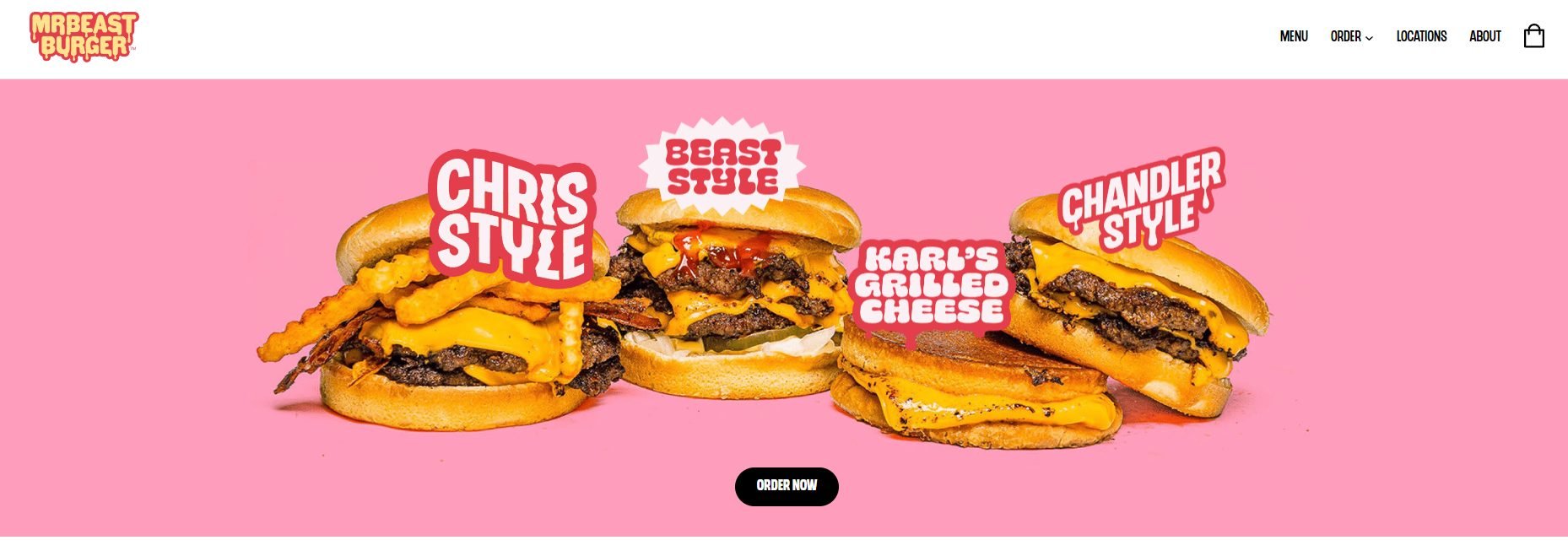
Image credit: mrbeastburger.com
This all happened on the back of his YouTube success.
Do your videos have to be flashy?
Only if you want to…
As I said earlier, most people want to relate to the people they watch on video. Having:
- cool effects
- whoosh sounds
- advanced transitions
- sports cars and models
…might backfire. Your niche selection also plays a role here.
Considering whether you’re primarily in the entertainment or education niche (though they might overlap) is a good place to start.
Some industries lend themselves to flashier videos. In others this wouldn’t make a difference (or even backfire).
Even more important to consider is YOU. More specifically, what do YOU want?
If you do not appreciate highly edited videos as a viewer, chances are your audience won’t either. The power of YouTube is that you tend to attract an audience that thinks like you over time.
Setting expectations with your YouTube monetization timeline
Having the right expectations is crucial to any business goal. Making money on YouTube is no different.
As we teach in YouTube Growth Engine, here is the timeline to YouTube dominance:
- Months 1-6: Focus on affiliate revenue
- Months 6+: Add ad revenue and sponsorship revenue
- Months 12+: Time to start building and selling your own course
These goals are in this order for a specific reason.
First, affiliate revenue is the easiest to generate. When your videos are getting views, your channel is getting more subscribers, and you’re learning better what your audience wants, it’s simple to add affiliate links to your videos that convert viewers into affiliate buyers.
Ad revenue and sponsorship revenue take a bit longer to profit from. With ad revenue, there are specific criteria to satisfy before you can monetize your YouTube channel.
With sponsorships, you’ll need somewhat consistent views to get companies to pay a set fee per video.
Finally, creating your course takes the longest to develop. Moreover, there are multiple key areas in the sales and marketing of the course in addition to its fulfilment.
That’s why I’ve listed it in the final position. At the same time, having your own course is the best leverage in your business. The faster you get to this stage, the better.
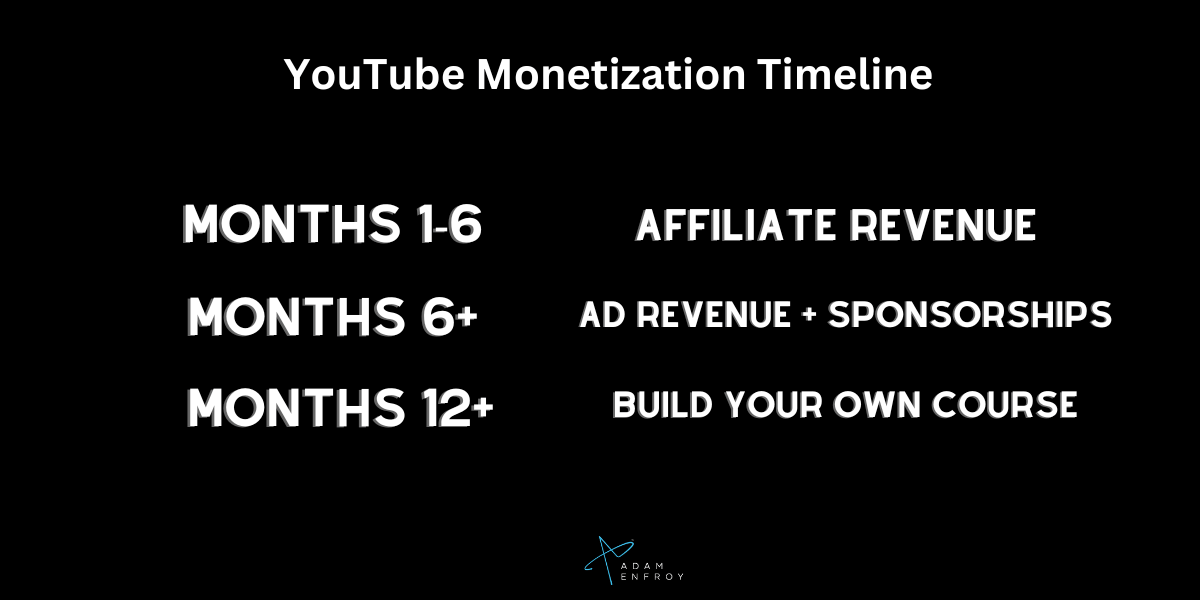
The monetization options we chose not to use (and why)
As you get to the end of this article, your mind might be full of hopes and dreams of YouTube money success (at least, that’s my hope for you).
Before I let you go, here are some options we could use to monetize our YouTube content – but choose not to. You don’t have to follow in our footsteps – these methods are only based on our values and experiences.
Running a faceless YouTube channel
With AI, creating a faceless YouTube channel has become easier. A faceless channel refers to creating automated content (using AI text generators, AI voice generators, and even AI video generators) within a specific topic.
The advantage of building such a channel is that content can easily be created – and at scale.
On the flip side, there’s not much personality involved with such channels. It’s difficult for people to connect with a channel without a human element.
As we believe in building the ‘brand of you’, we choose not to do this.
Selling our merch on YouTube
Many YouTube creators sell t-shirts, mugs, hats and plenty of other merchandize on YouTube. It’s not something we do.
Instead, we believe that promoting the right affiliate products and our courses is a much better leverage for our business. The profit margins on these products is also much higher than selling the cheaper stuff I mentioned.
Holding live YouTube streams
A feature of the YouTube partner program allows you to make money from your subscribers directly on YouTube. Again, this is something we choose not to do.
We believe in building a paid community on other community platforms and then running value-packed live streams inside these communities.
We see YouTube as a way to get people in the door while providing high-quality content others charge for. Then, we go above and beyond in our paid communities.
How you can steal our strategies (what comes next)
Making money on YouTube comes down to the value you provide to those who watch your videos.
Answering these questions can help:
- Can you teach these people stuff they will find super helpful?
- Would they be happy to pay for this information if they had to?
- Can you use third-party products and services to help make their lives better?
- Can you help companies make more money through your recommendations?
- Can you eventually build your own courses to help your audience even more?
If you can answer yes to at least one (hopefully all) of these questions, you have the foundation to make money on YouTube.
The next step?
Pick the best method for you based on your own YouTube journey and create a plan of action. Becoming a professional YouTube isn’t just a reality for millennials. It can also become yours.


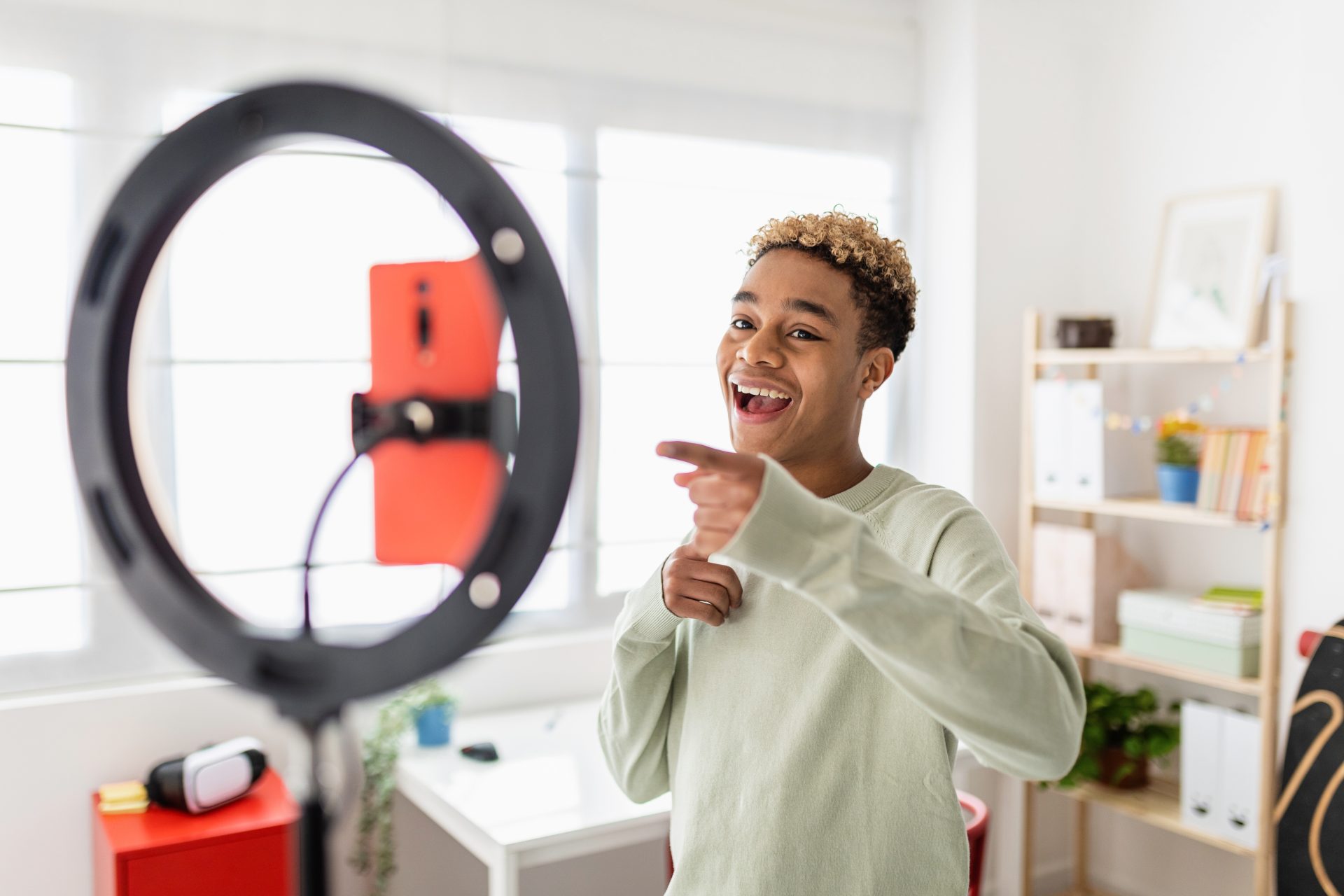



Hi Adam, I live all the 7 ways in this post. You are awesome and your story too.
Thanks for sharing
Hi, please I’m new here can you please give me the guidelines
Thanks, Adam!!
In my opinion, there are two main ways to monetize (get money from) your YouTube channel:
-Through Google AdSense, which is, the advertising shown by Google on your video
-Through sponsorships/endorsements. Here, you are paid to promote other people’s brands/product /services
First, monetizing through Google AdSense. If you are a YouTube channel with over 1,000 subscribers and 4,000 hours of watch time (the total hours people watched your videos), you can apply to YouTube’s Partner Program. If you are accepted, Google will start displaying AdSense on your videos. Basically, the more people who watched your videos (and viewed these ads), the more money you will get.
Second, sponsorships and endorsements. Here, you can either be passive and wait until a brand contact you, or you can reach to relevant brands and offer your services. How much you will get here will vary depending on many different factors, but especially your negotiation and bargaining skills.
Great article. You’ve probably used YouTube’s video hosting at least once. There, while watching a video, an advertisement “pops up”, sometimes from below, sometimes from the side of the screen, and sometimes the video itself simply starts with a 10–25 second commercial. This ad placement in your video is what allows video creators to earn money on YouTube. Work on the channel, i.e. shooting / creating videos. This is the main and most difficult. To earn money on a video, it is necessary that people watch it, subscribe to the channel, like (like rating) or dislike (rating not like). The video should be interesting, informative and original. You can upload only your video!
Hi Adam this article is great, You really Emphasize the possible way to a YouTube channel with the help of YouTube SEO. This article is Worth sharing, kudos to you!
Hi adam nice to meet you this artice is so helpful for starting a channel thank you have a wonderful day . Thank u thank u thank u
You are welcome 🙂
Amazing ways to make money on YouTube in 2019. Kindly give me some tips to get more subscribers on my YouTube channel. Thanks for sharing such a great article.
Hi Adam! I started out slow but now progressing faster than I knew I could. Your 7 Best Ways How to Make Money on Youtube is Awesome material. Thanks for sharing!
Glad you liked it. Thanks!
Amazing ways to make money on YouTube in 2019. Kindly give me some tips to get more subscribers on my YouTube channel. Thanks for sharing such a great article.
nice post sir thanks for this information
Kudos
Job Weldon
So useful all the steps everything is here thank you so much for your precious time and advice really grateful
Awsome way to make money! Thanks for the help.
Thank you for the insight! I have been working on growing my coaching business on YouTube and it’s a fun challenge and all information is greatly appreciated! Ivy
Hey
An really hoping to start a vlog soon via your help
Thanks so much
Do you still earn money if you are doing your YouTube channel in the country that is not your country of resident?
I think 2020 Ad Breaks is the best!
thank you adamenfroy for giving me wonderful information
Awesome! Thank you this came to me in a great time. I am looking to start a youtube channel. So much good information especially for beginners.!
Really great informative guide! I’ll be sharing this with a few of our clients 🙂
Hi adam.i read through your article but I have a question . Can one earn money on youtube just by watching ads ? Not being a content provider on YouTube.its called YouTubemoneys ..wanna know if it’s a scam .thanks
Hey Jasper, I haven’t read much into that but I assume it would be a small amount of money and something to avoid.
Thank you very much.I am starting to be Youtuber so I should make YouTube as a funnel for selling my digital product.
Love the energy it best way to make money right now in this time that we are living
Thanks for telling all the popular methods for YouTube. Affiliate marketing is very amazing. Can you please write a guide about Amazon Influencers Program. I could not understood their criteria for YouTube.
Thanks
Great article. I’m looking to create a YouTube channel aimed at helping my content rank better on google. In the meantime I’ll share the article with my email list!
Excellent article, at this time YouTube channel is great way to earn money. Thanks for your sharing to help us.
I’m a current YouTuber and trying to figure out my cpm
Thanks Adam for making this article. I really appreciate it!..
Thanks for sharing
thanks a lot adam. i have learned a lot my friend.
Great article. The basic point which you declared me very well that how do youtuber get paid. Thanks for the post. I love it.
Hey, Adam!
I am amazed to find your article in which you listed the best ways to make money from YouTube social media platform. Really Appreciated.
Keep updating us with trending topics related to YouTube.
The watch time have to be 40,000 hours with in any 12 months or within the first 12 months of creating the channel ???? Please tell me…
This is within any 12-month window of time.
Great article, Adam. I’m a first time visitor here and really like your fresh opinion on making money with Youtube. I just started monetizing my channel in April 2020 and have seen amazing gains in revenue through the Youtube Partner program. My advice is to make longer videos to increase your playback CPM and be consistent. As you gain more subscribers, your views and income grow as well. Youtube is a long term hustle so be sure to pick a good niche because you won’t see major revenue gains under your 2nd year. That’s when the magic happens and many Youtubers quit their day jobs to focus 100% of their energy on Youtube.
Thanks for the great information !
Great article. My problem is how to get traffic
Amazing ways to make money on YouTube. Kindly give us some tips to get more subscribers on my YouTube channel.